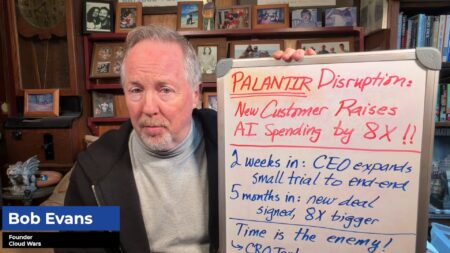Ditch the stock ticker. It doesn’t share the insights of what really happened in Q4 for the big tech firms. Why? There is more to what happened than just the numbers. So, what’s really going on with Microsoft, ServiceNow, SAP, and IBM?
First, Microsoft, again, solidified its #1 position on the Cloud Wars Top 10. The one-two punch of its Activision acquisition and FedEx partnership landed hard on its competition.
Second, the other tech companies rallied to expand their cloud impact. Cloud-native isn’t the only way forward as many companies have robust needs for hybrid or multi-cloud ecosystems.
In this Acceleration Economy “Lightning Strike”, John Siefert, Bob Evans, Aaron Back, Wayne Sadin, Kenny Mullican, and Leonard Lee give analysis on:
- How are these companies thriving due to cloud services?
- Are SMBs capitalizing on cloud tools to level the playing field with enterprises?
- Subscription models versus consumption models. Right or wrong?
- Are the large tech firms finally realizing the potential of dedicated security solutions?
Highlights
00:07 — The largest cloud providers released their quarterly earnings:
- Microsoft — Revenue was up 32% to $22.1 billion
- SAP — Revenue was up 28% to $3 billion with a current backlog of 32%
- IBM — Hybrid revenue was up 18% to $6.2 billion
- ServiceNow — Revenue was up 29% to $1.52 billion
01:54 — Although all four of these companies provide enterprise cloud services, they all serve different parts of the market. There’s an unquestionable underlying strength of the cloud market, as businesses are wanting more cloud services to help them thrive.
03:10 — Traditionally, software is thought of as a cloud opportunity associated with infrastructure. Software delivered as a service and subscription-based business models are becoming more widely adopted.
05:47 — As businesses move away from Infrastructure-as-a-Service, they’re moving toward Platforms-as-a-Service. Additionally, the pandemic has contributed to the increase in software sales.
08:13 — With the development of new technology, businesses have to evaluate how sustainable and profitable the solution is. As these four companies continue to experience growth, it shows that people are recognizing that this is the direction things are going.
11:03 — What enables these organizations to reach the goals they have set? Business functions will have to be reimagined through an AI and collaboration-first model.
13:42 — There’s a shift from subscription-based models, moving towards consumption-based models. This shift opens opportunities for more flexibility and scalability.
14:48 — A pivotal part of Microsoft’s growth is its $15 billion security business.
15:48 — While Microsoft has always had scale and security, the company hasn’t always had common branding and common reporting. Microsoft has had to determine how to manage this to better meet customer demands.
17:21 — Microsoft has been heavily focusing on Azure services and products, which is another contributing factor to its growth. The company has been challenged by cloud-based security startup companies.
18:46 — Accelerating cybercrime has become very common. So, Microsoft took advantage of an opportunity to improve its security offerings to go along with its platforms and other services.
23:14 — Many big technology companies entered the cloud to provide one specific solution. On the other hand, Microsoft approached it with intentions to go end-to-end and offer security across the whole range.
24:20 — SAP’s CEO specifically called out its new program, RISE. With that, other big vendors may start taking similar steps to improve customer experiences.
24:49 — Microsoft Dynamics 365 is up 45%, putting it at nearly being a $5 billion business. This makes Microsoft now have the fastest growing cloud SaaS business. Also, Microsoft’s Power Apps business was up 161% because corporations want to be able to use low code development.
26:00 — From SMBs to large enterprises, the scale of the Dynamics platform has been another major contributing factor to Microsoft’s growth.
26:46 — There’s going to be continued growth in innovation and fusing of technology elements. For instance, embeddable AI is on the rise—there may even be potential for embeddable Metaverse.
The cloud is powering the current business and future innovation with no stopping in sight. Moreover, the cloud is creating personalized experiences and opportunities across businesses, consumers, investors, and communities.
You can immerse yourself in the cloud and define your future by attending the Cloud Wars Expo.







